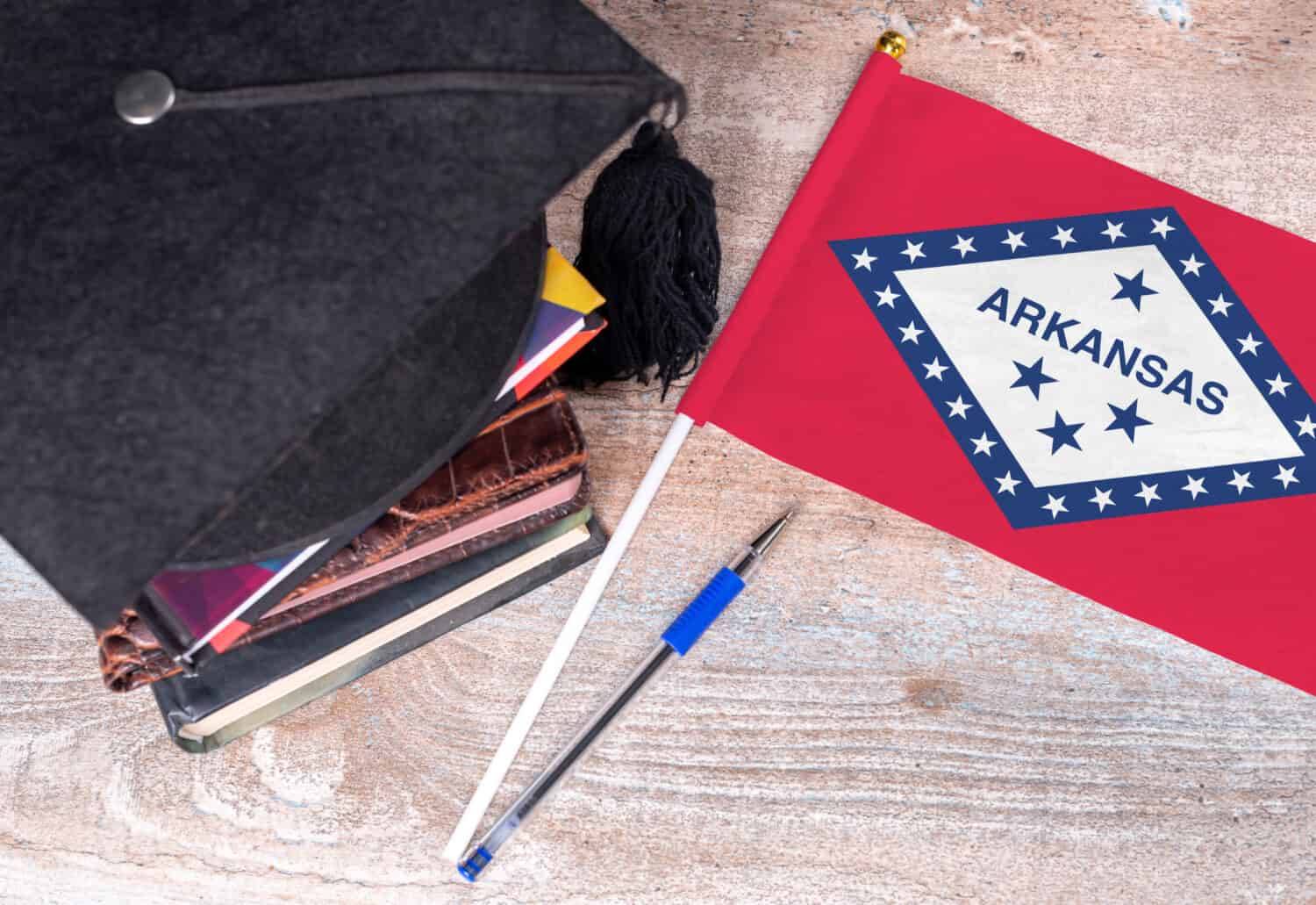The state of Arkansas is known for many things, from its Hot Springs National Park to Southern Hush Puppies. It’s also a state filled with great schools, but not all of them are at the top of the ranks. Today, we’ll tell you about the worst schools in Arkansas. While the staff at these schools likely try their best, the institutions just miss the mark on a few important indicators.
When we score the worst schools, we’re not stating our opinions but instead going off several metrics for this list. When scoring elementary and middle schools, we’ll be looking at factors like test scores, student progress, and equity. As we move into high school, we’ll be looking at those metrics plus how the school prepares the kids for college or life after school. Finally, we’ll be looking at the worst colleges in Arkansas. For universities, we’ll mostly look at graduation rates since that’s the ultimate factor if a school is ultimately successful.
Worst Schools In Arkansas: Elementary Schools
When kids go into elementary school, it’s essential that they are given the most supportive environment possible because, after kindergarten, this is one of their first steps into formal education. Failure to understand concepts now means that they could fall behind when they progress through the other grades. While many elementary schools in Arkansas are excelling, these miss the mark.
Marvell Primary School
This school, which is in the Marvell School District, is a smaller school with about 165 students. The school falls below average in several metrics, including student progress, test scores, and equity, according to GreatSchools.org. The website feels that students here are making far less academic progress compared to where they were last year and compared to other students in the state.
Test scores here are very low, even in general classes, including reading, English, math, and science. While kids at this age aren’t exactly supposed to be experts in their field, they should have a decent understanding of the basics, and the kids here aren’t quite getting that.
- The must-have convenient reference guide for every home cook!
- Includes more than 8,000 substitutions for ingredients, cookware, and techniques.
- Save time and money on by avoiding trips to grab that "missing" ingredient you don't really need.
On the equity front, there are some issues with disabled and underserved students. Currently, suspension rates for kids with disabilities are at 65%, which is compared to 22% for the other students. This isn’t good, regardless of the number. Any time that kids are out of school means that they aren’t in class learning. Students with disabilities are also chronically absent (absent for 15 days or more) more often than the other students. Again, they need to be in class.
On a bright note, 90% of the teachers are fully certified, and 100% of them have three years of experience or more, so there’s a lot of qualified teachers. There’s also a solid student-to-teacher ratio of 12:1, which means the students are getting fairly individualized attention.
Faulk Elementary School
As part of the West Memphis School District, Faulk Elementary School is a fairly large institution with 540 students. This school also has issues with student progress, test scores, and equity. Again, the students are making far less academic progress here when compared to other students in the state. Student proficiency in classes like English, reading, math, and science are all below 30%. Failure to succeed here could hamper their academic progress going forward.
On the equity front, white students are making more progress than other student groups, which indicates some achievement gaps. However, white students are also absent more often. This school also has an issue with disabled students being suspended more than their non-disabled counterparts. However, most startling is that chronic absenteeism is over 40% for kids who are considered disabled and those that aren’t. That means that kids are skipping school at an alarming rate, which is bad news.
Finally, while 100% of the teachers are certified, and 94% have three years of experience or more, there’s a high student-to-teacher ratio of 18:1, which indicates that the students aren’t always getting the attention they need. There’s also only one student counselor for every 632 kids.
Lafayette County Elementary School
As the main school in the Lafayette County School District, the school with the same name should be the peak institution of the area. However, this school, with 304 students, has some work to do. Similar issues here are with student progress, equity, and test scores. The students are making far less academic progress when compared to other students in the state. Test scores here are quite low, especially in math, where there’s a 5% proficiency.
Equity is also a problem here, with underserved students falling behind others in certain areas, including test scores and student progress. While disabled students are suspended less often than the other students, they are chronically absent more often. On the bright side, the school is a bit more diverse than some of the others on this list. As far as teaching, 100% are certified, and only 86% have three years of experience or more. Also, the 16:1 student-to-teacher ratio is a bit high.
Worst Schools In Arkansas: Middle School

©Monkey Business Images/Shutterstock.com
When the students move on to middle school, they should get the extra attention they need to build on their current knowledge and grow as individuals. This is also the point where many students start taking advanced classes, and so they need the appropriate support. There are 613 middle schools in Arkansas, and many are quite good, but these have some room for improvement.
Mabelvale Middle School
This school, in the Little Rock School District, is lacking in some important areas, including test scores, student participation, and equity. While not as bad as some other schools on this list, the students at this middle school are making less academic progress compared to how they were doing the previous year.
Part of the problem is the test scores, which fall far below the state averages in most major categories. In math and science, there’s less than a 10% proficiency. There are also very few students taking advanced courses like Algebra 1. Of the 10% who take the class, there’s less than a 1% pass rate.
One of the most concerning issues at this school is the suspension rates. Many student groups are suspended at alarming rates. Black students are suspended at 42%, white students are suspended at 32%, and students of two or more races are suspended at 50%. That means that many students in the school are missing out on blocks of education, and it doesn’t bode well for the future. There’s also the issue here with disabled students being suspended more than students aren't considered disabled.
Cloverdale Middle School
Also in the Little Rock School District, this school of 601 students has some room for improvement with test scores, student progress, and more. Test scores need a lot of help here as there’s a low proficiency in core classes, including English, reading, math, and science. Math proficiency is at 3%. There are also very few students taking advanced courses. Only 7% of students are taking Algebra 1, and there’s a pass rate of under 1%.
This is yet another school where students are suspended at an alarming rate. Students of all races are suspended at 19% or more. Even worse is the fact that students of all races are chronically absent at 33% or more. Remember, chronically absent means that they’re out of school 15 days per year or more, so they’re not in class learning the skills that can help them thrive as they eventually grow into adults.
Finally, 100% of the teachers are certified, but only 75% have three years of experience or more, and that lack of experience may affect how the students are progressing during their middle school career.
- The must-have convenient reference guide for every home cook!
- Includes more than 8,000 substitutions for ingredients, cookware, and techniques.
- Save time and money on by avoiding trips to grab that "missing" ingredient you don't really need.
Camden Fairview Middle School
Finally, there is this school in the Camden Fairview School District. It has 564 students in grades 6-8, and it has some issues with test scores and student progress. Like the other middle schools here, the scores in classes like reading, math, and science are very low, and the students are falling far below others in the state. A couple of bright spots include the fact that English proficiency is at 50%. Plus, there’s an Algebra 1 participation rate of 51%, which is great, and there’s a 100% pass rate.
However, there are some issues with equity. Low-income and other underserved students are falling behind the other students when it comes to test scores and overall progress. Plus, students with disabilities here have suspension rates of 48%, which is much higher than the state average of 13%. It’s also higher than the 16% suspension rate of the students in the school who aren't considered disabled.
Finally, this school has a similar issue as the last school when it comes to teaching. While 100% of the teachers are certified, only 75% have three years of experience or more. Unfortunately, they’re also being underpaid. They average about $40,000 per year compared to the state average of $50,000, and that doesn’t help matters.
Worst Schools in Arkansas: High Schools
Success in high school is paramount for students. A good high school will continue to educate the kids while also preparing them for the next stage: college. Even if a student is not planning to go to college, their high school must prepare them for life in the real world. That’s why, in this section, in addition to talking about test scores and student progress, we also gauge the schools based on college preparedness.
Springdale High School
First is Springdale High School, which is part of the Springdale School District. It’s a large school with 2,000 students in grades 10-12. The school has “below average” ratings by GreatSchools in the categories of test scores, student progress, college readiness, and equity.
Test scores are low in general subjects, including reading, English, math, and science. There’s also a shortage of students taking advanced classes, with only 4% taking AP math and 6% taking AP science. On the bright side, the school has a 4-year graduation rate of 85%. However, the students aren’t taking the classes to excel if they go to college. Sadly, only 23% of students plan to attend college or a vocational program.
On the equity front, low-income and other underserved students are falling behind the other students when it comes to college readiness and student progress, indicating some achievement gaps. Also, students with disabilities are suspended more often than students that aren’t considered disabled. All in all, there are some issues that this school needs to work out.
Osceola High School
Located within the Osceola School District, this is a smaller school with about 310 students in grades 9-12. Although the students here are making average academic progress compared to where they were last year, there are some other issues.
The test scores here are far below others in the state. While English proficiency scores are close to 30%, the numbers for reading, math, and science are in the single digits. Like the other school, there are very few students taking the advanced classes, like AP math and science, which could prepare them for success in college.
There’s an 80% graduation rate, but only 19% of students intend to attend college or a vocational school. Of those that do attend college, 97% require remediation in college, which means that the high school likely did not properly prepare them for the next level. Students who take the ACT score for acceptance in college have an average score of 15, which is well below the average of 21 that most schools look for when considering acceptance.
There are also similar issues with equity as at the last school. Finally, while 96% of schools are fully certified, only 73% have three years of experience or more, and that lack of experience may be a reason for the poor student progress.
Marvell High School
Finally, there’s Marvell High School in Marvell, Arkansas. This school has many of the same issues as the other two schools when it comes to test scores, student progress, and college readiness. Only 34% of students intend to attend college, and those who choose to are performing below average on the ACT scores. The average score is 14, which is low compared to the minimum score of 21 that most colleges look for when considering applicants.
Test scores are also very low at this school, with proficiency levels in the subjects of reading, math, and science landing in single digits. Participation in advanced courses like AP math and science is also very low, with less than 1% in some cases.
Part of the issues at this school may revolve around the teaching. While 95% of the teachers are certified, only 64% have three years of experience or more, which can be a reason why students aren’t passing their classes. The other area of concern is teacher salary. Currently, the average salary here is $30,000, which is below the state average of $71,000. When the pay is low, the teachers may have less motivation, and that’s a problem.
Worst Colleges in Arkansas

©PeopleImages.com – Yuri A/Shutterstock.com
When we consider the worst colleges in the state, there are many possible metrics. However, we choose to go with the graduation rate. Students may not graduate from a school for several reasons. They may not have the support they need, they may not like the school and transfer elsewhere, they may find the school to be too expensive, etc. There can be many reasons, but in any case, a low graduation rate is a good indication of a poor school. These are the schools in Arkansas with the lowest graduation rate, according to CollegeSimply.com:
- Ecclesia College – 5.9% Graduation Rate
- Pulaski Technical College – 11% Graduation Rate
- Mid South Community College – 11.2% Graduation Rate
- Southeast Arkansas College – 18.2% Graduation Rate
- North Arkansas College – 22.9% Graduation Rate
- Ozarka College – 23.7% Graduation Rate
- University of Arkansas Fort Smith – 24.3% Graduation Rate
Conclusion
That’s your list of some of the worst schools in Arkansas. Keep in mind that these schools do have their finer points, but there are certainly areas of improvement. It’s important for parents to do their research before putting their kids in a school. Find a school that will help them to succeed and thrive as they get older, and you’ll be setting them up for success.
The image featured at the top of this post is ©BERMIX STUDIO/Shutterstock.com.
- The must-have convenient reference guide for every home cook!
- Includes more than 8,000 substitutions for ingredients, cookware, and techniques.
- Save time and money on by avoiding trips to grab that "missing" ingredient you don't really need.

